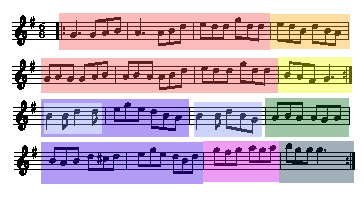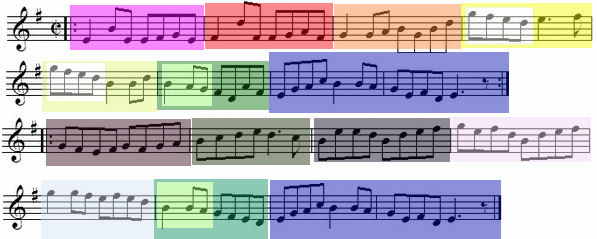
Growing a Tune: A Bit of Analysis

I was talking to my friend Ned the other day about tune writing. Somehow we got onto the topic of what it means to write good music that is clearly part of a specific genre. For example, what does it mean to write Celtic music? What are the traits that define that style of music? And, within those set of definable traits, what distinguishes a good tune from one that is less desirable? Also, what happens when a tune lives near the boundaries of those definitions? All interesting questions.
This got me thinking about why it has been fun to play and record The Marlin Spike. I’ve written a lot of tunes. Some of them I just don’t care to ever play again. But I enjoy The Marlin Spike. And it seems that others do too. Why? What makes it likable?
So, to help answer that question, I decided to do a little graphical analysis on The Marlin Spike comparing it to The Kesh Jig. Now, bear in mind that The Kesh Jig may be the most popular Irish tune in the world. You can find a recording of The Kesh on no less than seventy-five albums. In fact, it is built-in to any whistle, flute or fiddle when you buy it. Comes right out with no training at all.
The Marlin Spike, on the other hand … well, let’s just say it has a ways to go to catch up to The Kesh.
Here is what I did: I looked at both tunes and color coded all the measures. Blocks of color that are the same are thematically the same. If a color only appears once, it is because that measure is unique. So here goes, first The Kesh (take a listen to an mp3 I found out on the web):

You can quickly see that the first three measures are thematically the same as measures five through seven. Next you can see that measures nine and ten are thematically the same as thirteen and fourteen. Also, I’ve tried to indicate that measure thirteen and fifteen are very similar as well.
Another way to look at this is that there is an A section that is repeated twice and a B section that is repeated twice. The A section is essentially broken into two halves that are basically the same. The B section is also broken into two halves that, although a bit more unique, thematically don’t differ all that much. The only unique measures are towards the end of the phrases.
Ok, on to The Marlin Spike, which can be heard here.

In The Marlin Spike we see an entirely different story. There are so many colors, in fact, that I had to move away from primaries and secondary colors and start using tertiary colors to identify unique measures. The exceptions, of course, are the last two measures of both the A strain and the B strain, which are exactly the same. There are also some other minor similarities. For example, the first half of the fourth measure is the same as the first half of the fifth measure. Likewise the first half of measure six and fourteen. Other than that, the measures are unique.
One subjective observation that I have made when comparing how these two tunes sound, verses analyzing their structure, is that similar measures placed towards the tail of the strain seem to have a less defining affect on the overall theme of the tune than similarities towards the beginning of the strain. For example, The Kesh’s major similarities are in the beginning of the strains while The Marlin Spike’s similarities are a the tail end of the strains. The heart of The Kesh is very much defined by those opening measures. They are the ‘tell’ of that tune. In fact, I would put money on the fact that anyone that has ever played and Irish tune would be able to name-that-tune with just the first measure of The Kesh. I would also argue that it would be much more difficult to name-that-tune, even if The Marlin Spike was super-duper-famous, with just the seventh measure, which is the measure that is again repeated in the fifteenth measure.
It is, therefore, my observation that similar thematic measures towards the end of a phrase are less likely to be consciously noticed by the listener. I do believe, however, that they do serve a valuable purpose. They serve to give the tune a foundation so as not to feel random or thematically lost. Those measures tie up all the loose ends and bring it all home, which makes us feel good.
So, what is the conclusion? Well, The Marlin Spike is more thematically complex than The Kesh. There is more variation, which certainly keeps things interesting. Does that make it better. ‘Fraid not. Just different. Because of its complexity, it may have more appeal to those who have been playing this style of music for many years. Following that logic, it may be unappealing to those who are fairly new to the jigs and reels and may be looking for tunes that are a bit more grounded up front.
Suffice it to say, that as a tune author, these are things that I intuitively think about as I’m writing. To dial up the interest, repeat measures less often; to drive home a theme, repeat measures more often. Admittedly, this is just one lens to view a tune through and, luckily, there really are no rules.